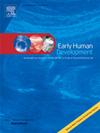出生时妊娠与产妇敏感性之间的关系:一项个体参与者数据(IPD)荟萃分析
IF 2
3区 医学
Q2 OBSTETRICS & GYNECOLOGY
引用次数: 0
摘要
背景和目的已有研究证明,早产母亲(妊娠37周)和足月婴儿的双染色体敏感性存在差异,但研究结果不一致,而且研究通常包括小样本和异质性样本。目前尚不清楚,在整个孕龄范围内,产妇敏感性的变化与早产的关系有多大。目的进行系统回顾和个体参与者数据(IPD)荟萃分析,评估根据出生时胎龄观察到的双元母体敏感性的变化,同时调整已知的与母体敏感性相关的混杂因素。方法采用混合效应线性回归对来自10个国家的12个出生队列的数据进行汇总,并进行一期IPD荟萃分析(N = 3951)。根据每个队列中当代足月出生对照的评分,对产妇敏感性进行z标准化。所有模型都根据儿童性别、评估年龄、神经发育障碍、小于胎龄分娩和母亲教育程度进行了调整。结果在所有12个队列中,出生妊娠期与母亲敏感性之间的固定线性效应较小但稳定(0.02 /周[95% CI = 0.01, 0.02], p <;措施)。母亲教育的二元效应(0.32 [0.24,0.40],p <;.001)和儿童神经发育障碍(- 0.33 [- 0.50,- 0.17],p <;.001)与母体敏感性相关。出生胎龄与产妇双元敏感性呈正相关,但影响的大小很小。在妊娠期之后,母亲教育和儿童神经发育障碍似乎会影响敏感性,这突出了在未来的研究和干预设计中考虑这些因素的重要性。本文章由计算机程序翻译,如有差异,请以英文原文为准。
The association between gestation at birth and maternal sensitivity: An individual participant data (IPD) meta-analysis
Background and aim
Studies have documented differences in dyadic sensitivity between mothers of preterm (<37 weeks' gestation) and term born children, but findings are inconsistent and studies often include small and heterogeneous samples. It is not known to what extent variations in maternal sensitivity are associated with preterm birth across the full spectrum of gestational age.
Objective
To perform a systematic review and individual participant data (IPD) meta-analysis assessing variations in observed dyadic maternal sensitivity according to child gestational age at birth, while adjusting for known confounders correlated with maternal sensitivity.
Method
We harmonised data from 12 birth cohorts from ten countries and carried out one-stage IPD meta-analyses (N = 3951) using mixed effects linear regression. Maternal sensitivity was z-standardised according to the scores of contemporary term-born controls within each respective cohort. All models were adjusted for child sex, age at assessment, neurodevelopmental impairment, small for gestational age birth, and maternal education.
Results
The fixed linear effect of the association between gestation at birth and maternal sensitivity across all 12 cohorts was small but stable (0.02 per week [95 % CI = 0.01, 0.02], p < .001). The binary effects of maternal education (0.32 [0.24, 0.40], p < .001) and child neurodevelopmental impairment (−0.33 [−0.50, −0.17], p < .001) were associated with maternal sensitivity.
Interpretation
Gestational age at birth is positively associated with dyadic maternal sensitivity, however, the size of the effect is small. Over and above gestation, maternal education and child neurodevelopmental impairment appear to affect sensitivity, highlighting the importance of considering these factors in future research and intervention designs.
求助全文
通过发布文献求助,成功后即可免费获取论文全文。
去求助
来源期刊

Early human development
医学-妇产科学
CiteScore
4.40
自引率
4.00%
发文量
100
审稿时长
46 days
期刊介绍:
Established as an authoritative, highly cited voice on early human development, Early Human Development provides a unique opportunity for researchers and clinicians to bridge the communication gap between disciplines. Creating a forum for the productive exchange of ideas concerning early human growth and development, the journal publishes original research and clinical papers with particular emphasis on the continuum between fetal life and the perinatal period; aspects of postnatal growth influenced by early events; and the safeguarding of the quality of human survival.
The first comprehensive and interdisciplinary journal in this area of growing importance, Early Human Development offers pertinent contributions to the following subject areas:
Fetology; perinatology; pediatrics; growth and development; obstetrics; reproduction and fertility; epidemiology; behavioural sciences; nutrition and metabolism; teratology; neurology; brain biology; developmental psychology and screening.
 求助内容:
求助内容: 应助结果提醒方式:
应助结果提醒方式:


